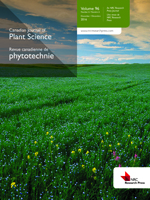Gravel, V., Dorais, M., Dey, D. and Vandenberg, G. 2015. Fish effluents promote root growth and suppress fungal diseases in tomato transplants. Can. J. Plant Sci. 95: 427-436. Aquaculture systems generate large amounts of wastes which may constitute a beneficial amendment for horticultural crop in terms of nutrients, plant growth promoter and disease suppressiveness. This study aimed to determine (1) the nutrient value of rainbow trout farming effluents coming from two feed regimes and (2) the plant growth and disease suppressiveness effects of those fish farming effluents on tomato transplants. The effluent sludge from Skretting Orient™ (SO) had a higher content of P (38 vs. 32 mg L-1), K (23 vs. 11 mg L-1), N (19 vs. to 11 mg NO3 L-1; 186 vs. 123 mg NH4 L-1), and a higher NO3:NH4 ratio (1:9 vs. 1:13) compared with the Martin Classic (MC), while MC was richer in Mg (42 vs. 24 mg L-1) and Ca (217 vs. 169 mg L-1). For the first trial, a stimulating effect of the fish effluent was observed on plant height, leaf area and root dry biomass, while only the root biomass was increased during the second trial. Fish sludge was rich in microorganisms (97 and 142 µg fluorescein h-1 mL-1 for SO and MC, respectively) and their ability to suppress Pythium ultimum Trow and Fusarium oxysporum f.sp. lycopersici (Sacc.) Snyder & Hansen was observed. Both crude fish effluents reduced in vitro mycelial growth of P. ultimum and F. oxysporum, by 100 and 32%, respectively, while MC effluents showed a higher inhibition against F. oxysporum. When fish effluents were sterilized by filtration or autoclaving, lower in vitro inhibition of P. ultimum and F. oxysporum was observed. Mixed fish effluents reduced tomato plant root colonization by P. ultimum (by up to 5.7-fold) and F. oxysporum (by up to 2.1-fold). These results showed that fish effluent can be used as soil amendments to promote plant growth and increase soil suppressiveness, which in turn can prevent soil-borne diseases.
How to translate text using browser tools
5 December 2014
Fish effluents promote root growth and suppress fungal diseases in tomato transplants
Valérie Gravel,
Martine Dorais,
Dipa Dey,
Grant Vandenberg
ACCESS THE FULL ARTICLE
It is not available for individual sale.
This article is only available to subscribers.
It is not available for individual sale.
It is not available for individual sale.

Canadian Journal of Plant Science
Vol. 95 • No. 2
March 2015
Vol. 95 • No. 2
March 2015
agents pathogènes du sol
amendements
éléments nutritifs
Fusarium oxysporum
Fusarium oxysporum
greenhouse tomato
plant nutrients




